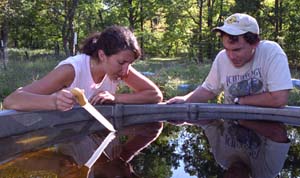A WUSTL undergraduate has discovered the existence of an Asian mosquito species outside of St. Louis that is a vector of the West Nile virus and St. Louis encephalitis.
The discovery is the first reporting of Ochlerotatus japonicus (Oc. japonicus) in Missouri and marks the western-most record of the exotic species in the central and eastern United States.

Stephanie Gallitano, a junior chemistry student in Arts & Sciences — working with WUSTL postdoctoral researcher James Vonesh, Ph.D. — was examining egg-laying sites in artificial ponds at the University’s Tyson Research Center in mid-June. When she took egg masses back to a laboratory and examined them, she found some unusual larvae.
“Under the microscope, they looked completely different than anything I’d ever seen before,” Gallitano said. “It had different proportions for its body. I looked through all of the books and could find nothing like it.
“It was pretty thrilling to discover it.”
The two then took the larvae to Leon Blaustein, Ph.D., who holds joint appointments with Rutgers University and the University of Haifa in Israel, and was a sabbatical visitor to Washington University. The larvae were eventually identified as Oc. japonicus at his Rutgers laboratory.
The researchers collected 10 mosquito larvae from 15 individual artificial pools spread widely throughout Tyson Research Center.
“This exotic species, it turns out, is the second-most-common species overall in the pools,” Gallitano said. “The first was the common house mosquito. It’s possible that it’s been here for some time, maybe even a few years.”
Vonesh said it is highly likely that Oc. japonicus has spread from the east, and that means it’s probable that the species is in Illinois and perhaps other Midwestern and prairie states. The farthest west — excluding Washington state, the only known state reporting the species in the West — the species had been documented was Michigan.
September is the peak month when West Nile virus tends to be most abundant in the mosquito population because all summer long it has been amplifying within the bird community, the researchers said.
Oc. japonicus was first reported in New York state and New Jersey in 1998. By 2003, it had been reported in at least 19 other states in the eastern United States.
The researchers will publish their results in a forthcoming issue of the Journal of Vector Ecology. The Tyson Research Center/Howard Hughes Medical Institute’s Undergraduate Research Program supported Gallitano in her 12 weeks of research this summer.
More than 20 mosquito species have tested positive for West Nile virus in the field, and some of them also maybe vectors for other human diseases like St. Louis encephalitis. There are countless millions of mosquitoes, but even those who are vectors of disease prefer to take blood meals from birds rather than humans — their last resort.
Thus, Vonesh said, the movement of Oc. japonicus westward, is not a cause for alarm, rather a scientific item of note.
“Some species are better vectors than others,” Vonesh said, “and one of the questions we need to answer is: Has this species replaced another as one of the better vectors?”
The researchers hope to understand more about the ecology of Oc. japonicus and its interactions with other mosquitoes in future work.
A colleague who studies mosquitoes and ecosystems, Jonathan Chase, Ph.D., assistant professor of biology in Arts & Sciences, said the find should be kept in perspective.
“Even though these diseases are serious, people can take normal precautions and still enjoy the outdoors,” Chase said. “We don’t need to spray every wetland and every tree hole and kill every mosquito to live as we always have.
“Birds are the primary reservoir of the diseases, and humans are the ‘accident’ — the diseases don’t want to be in the human. We don’t amplify them; we don’t give them back to the mosquito and keep it going.”